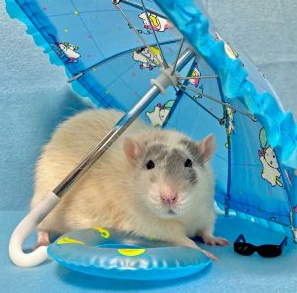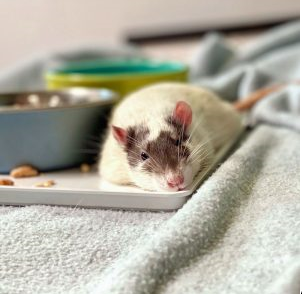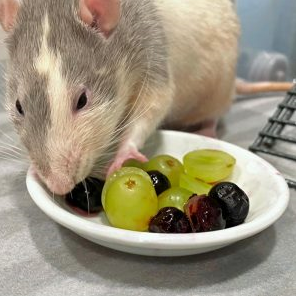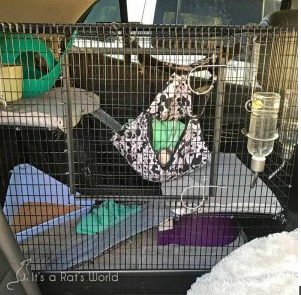Keep Pet Rats Cool When It’s Hot
Rats need protection from hot temperatures.
With the summer months upon us, many people are basking in the sun and enjoying the warm weather. I personally don’t love the heat, but that’s probably because I live in a city where summer means 100 degrees or higher. I spend most of my days plotting ways to stay indoors with air conditioning.
I’m not the only one sensitive to my environment, however. Temps that are too high or too low can cause discomfort and stress to your rats and can even lead to health problems. Rat owners should ensure that their pets remain in a temperature-controlled environment of 72 to 80 degrees Fahrenheit.
Beware These Signs Of Discomfort
A rat lying down and stretched out could be signaling that the temperature is too warm. Brandi Saxton of It’s A Rat’s World
Rats can’t verbally tell you when they are uncomfortable, so pay attention to their body language for clues. Some websites say rats show considerable discomfort at around 90 degrees Fahrenheit. In my personal observation, however, rats begin exhibiting major discomfort at 82 to 83 degrees. The fact is, rats can experience heatstroke at temperatures over 80 degrees, which could lead to death.
Rats don’t have sweat glands. Instead, rats use blood vessels in their tails to help regulate their body temperature. A hot rat often has a warm tail or even warm feet. They also use their own saliva to help cool themselves. They lick their body and the evaporation causes some cooling.
When rats start getting too warm, they often become less active and may stretch out flat on their stomachs or backs. This puts as much of their body touching a cool surface as possible and/or lets heat out through their tails and feet. It’s best at this point to try and cool them down before things progress to heat exhaustion or heatstroke.
Signs to be on the lookout for are: lethargy, weakness, refusing to eat, or drooling/salivating. There’s also risk of them losing consciousness or going into convulsions. If any of these happen, it’s imperative that you start bringing their body temperature down and then rush them to a veterinarian. More on this later.
Ideal Ways To Beat The Heat
Avoiding a medical emergency is the main goal. Make sure your rats are well-hydrated and have continual access to water. This is vital. Being able to regulate the temperature of the room your rats are kept is also important. It’s best to provide them with AC or evaporative cooling during warm months. My rats are kept in an add-on room of our new house, which is separate from the venting system. Instead, a wall-mounted unit was installed to help keep the room comfortable.
Creative Ways To Beat The Heat
Brandi Saxton of It’s A Rat’s World
In addition to always having clean, fresh water available, offer your rats foods that contain lots of water.
But what do you do if you find yourself in a situation where you can’t control the temperature? During a few bad summers our AC unexpectedly died. With the temperature outside in the triple digits, it wasn’t long before our house started to heat up. In situations like this, you’ve got to get creative!
Seek coolness, limit light, and cover windows. First, move your rats to the coolest room in your home. Then, limit the number of lights being used, as they generate a surprising amount of heat. Closing your blinds or curtains can also reduce the heat load. Normally I prefer natural light in my rats’ room, but lately it’s been too hot to open the blinds, even with the wall unit running.
Consider using fans. Bringing out a fan helps only if you can keep your rat’s fur damp. The evaporation of moisture off skin is what cools a body down. Rats can’t sweat, so it’s up to you to provide them that moisture. Misting them with a spray bottle helps. Also, lay wet paper towels or damp cloths around the floors of their cage. Always leave them some dry areas as well.
Offer foods with high water content. Encourage your rats to continue drinking water and offer them fruits such as grapes, melon, strawberries, blueberries, or anything else with a high water content.
Create cooler surfaces for them to stretch out on or lay up against. For instance, a single ceramic tile placed inside the cage stays cool to the touch. You can also fill plastic food containers, stainless steel beverage bottles, glass jars, or resealable bags with ice, or freeze a bottle of water. Then wrap these items in a thin towel to protect delicate skin, place them around the cage, and set your rats on or next to them. It may take them a moment to get used to the idea, but eventually they should find heat relief at these cold spots throughout the cage. Keep an eye out for any water leakage from melting ice. Refill when necessary.
Adapt When Coolness Remains Out Of Reach
If circumstances prevent your home from having an area cool enough for your rats, you might need to take them elsewhere until the heat situation is fixed.
Brandi Saxton of It’s A Rat’s World
Continue monitoring your rats’ well-being and the temperature of the room. If it continues to climb or your rats are showing increased discomfort, then it’s time to relocate them. If our house gets to 87 degrees and the AC repairman is still hours, if not a day behind schedule, then we change plans. To avoid a catastrophe, we get the rats set up in their travel cage and to the home of a friend or family member until our home is cool again.
Because life is always throwing unexpected curveballs, I highly suggest having an emergency plan in place during the summer months. Evacuating and emergency vet trips can be scary, but planning ahead lessens the stress.
Know What To Do If A Veterinary Visit Is Needed
If the worst should happen and your rat starts showing signs of heatstroke, you must take action. The following six tips are based on information from Thomas M. Donnelly, DVM, MS, DACLAM, DABVP, DECZM, with additional explanation from Karen Grant RN.
1. Try to bring the body temperature down so you can get the rat to a vet.
2. NEVER submerge your rat in cold water! This can result in vasoconstriction, causing heat to be retained by the body instead of allowing heat to dissipate.
3. Instead, wet your rat’s fur with tepid/lukewarm water and apply a covered ice pack to their neck, armpits or groin, and then use an electric fan to induce evaporative cooling. These axillary and inguinal areas have large blood vessels close to the skin’s surface, which will help cool the body down faster. An ice pack to the neck specifically will cool blood going to their brain.
4. To prevent an ice burn, make sure to use a thin piece of cloth or towel between the ice pack and skin.
5. Either make smaller, rat-sized ice packs or lay your rat, abdomen side down, across a large ice pack to reach all the important areas at once.
6. If possible, keep your damp rat on the ice with your car’s AC blowing as you drive to the vet clinic.
Enjoy Safe, Summer Fun
Fishing for frozen peas is a fun, safe way for rats to keep cool.
Brandi Saxton of It’s A Rat’s World
Even in a cool and comfortable home, one of my favorite summer enrichment activities for rats is pea fishing. Set this up for them in their play area.
All you need is a container filled with water (I prefer filtered water from my fridge door), and a bag of frozen peas. The type of container can vary. Many people use a paint roller tray or a shallow baking dish. Last summer I decided to try something deeper and clear so that I could get some fun “underwater” photos of the rats. It took a while before they were willing to touch the water (frozen peas make it very cold) or submerge their arms deep enough to reach the bottom of the dish, but once they did, they were pea fishing for a good 45 minutes!
Just make sure that whatever container you choose won’t easily tip over, and pace out the peas to stretch the activity time. And definitely have a camera ready to capture the experience.
It’s hot out there, stay cool!
Shared with permission from Lafeber
https://lafeber.com/mammals/keep-pet-rats-cool-when-its-hot/





